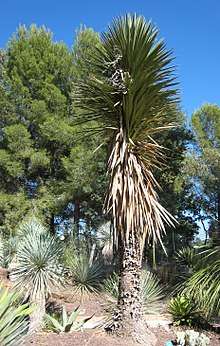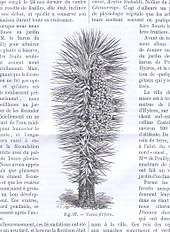Yucca filifera
Yucca filifera is a member of the subfamily Agavaceae, family Asparagaceae, native to central Mexico.
| Yucca filifera | |
|---|---|
 | |
| Scientific classification | |
| Kingdom: | Plantae |
| Clade: | Tracheophytes |
| Clade: | Angiosperms |
| Clade: | Monocots |
| Order: | Asparagales |
| Family: | Asparagaceae |
| Subfamily: | Agavoideae |
| Genus: | Yucca |
| Species: | Y. filifera |
| Binomial name | |
| Yucca filifera Chabaud | |
| Synonyms[1] | |
| |
History
It was discovered in 1840 in northeastern Mexico between Saltillo and Parras (23°37′0″N 102°34′30″W) on 19 May 1847 by merchant and explorer Josiah Gregg.[1] It was later introduced to Europe and described for science by J. Benjamin Chabaud (1833-1915) in 1876.[1]
Description

A tall, heavily branched yucca, Y. filifera has straight, ensiform leaves growing in rosette-shaped bunches from the end of each stem.[2] Its inflorescence hangs over and is made of many separate white flowers.[2]
Cultivation
Y. filifera can be cultivated in xerophytic conditions. It is used as roof covering and as a source of fibre for handcrafting by the indigenous people, who call it palma china or izote.[3]
Am enormous specimen of Yucca filifera stands in front of the Anderson Gallery at the Cantor Arts Center, Stanford University. It was transplanted to this site in the 1880s. In the spring, it bears long clusters of white flowers, some well over a meter long.[4]
| Wikispecies has information related to Yucca filifera |
| Wikimedia Commons has media related to Yucca filifera. |
References
- Yucca filifera Chabaud, Tropicos, Missouri Botanical Garden, 2013
- R.J. Hodgkiss, The Yucca Page, 20 February 2012, accessed 25 March 2013
- Palma china, Izote, Palma corriente, Palma grande - Yucca filifera, InfoJardin, Jardineros Paisajismo Plantas, 2013, accessed 25 March 2013
- Yucca filifera, from Trees of Stanford
See also
- Zdeněk Ježek; Libor Kunte (July 2007). Encyclopedia of Succulents. Bookmart Limited. ISBN 978-90-366-1705-5. Retrieved 25 March 2013.